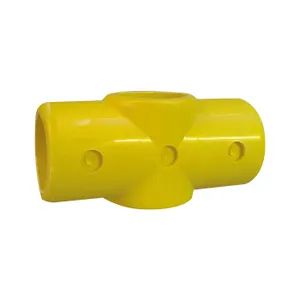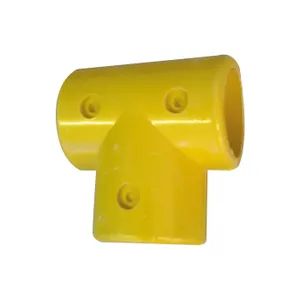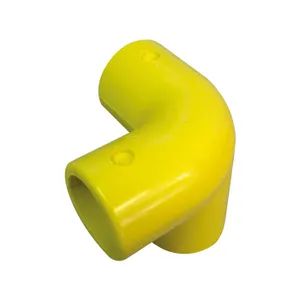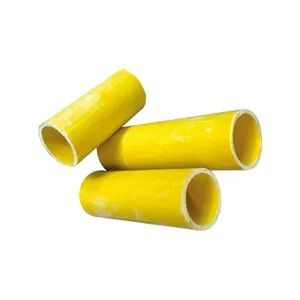Unser GFK-Handlaufsystem wird häufig in GFK-Handläufen oder -Geländern verwendet, um den Mittelholm in einer 90°-Ecke weiterzuführen, vertikale Pfosten mit dem Oberholm zu verbinden oder den Mittelholm mit dem Endpfosten zu verbinden.
Einführung zur Produktleistung
|
|
Das externe GRP-Drehgelenk ist ein vielseitiger Inline-Drehbeschlag, der häufig bei unterschiedlichen Winkeln an Abhängen, Stufen und Podesten verwendet wird. |
|
Die GRP 116 Mid Corner ist eine 90°-Eckverbindung, die häufig in GRP-Handläufen oder -Geländern verwendet wird, um den Mittelholm in einer 90°-Ecke fortzusetzen. Sie kann aber auch zum Bau rechteckiger oder quadratischer Strukturen verwendet werden. Der Pfosten verläuft vertikal durch die GRP-Halterung. Wird häufig mit der GRP-128 Top Corner verwendet. |
|
|
Das kurze T-Stück GRP 101 ist eine 90°-T-Verbindung, die typischerweise in einem GRP-Handlauf verwendet wird, um vertikale Pfosten mit der oberen Schiene zu verbinden oder die mittlere Schiene mit dem Endpfosten zu verbinden. Das Rohr kann nicht oben an der Armatur angeschlossen werden. Das lange T-Stück GRP-104 kann als Alternative verwendet werden, falls dies erforderlich ist. |
|
Das GFK-Fitting 119 Midrail Cross ist ein 90°-Verbindungsstück, das häufig verwendet wird, um die Mittelschiene mit einem Zwischenpfosten in einem GFK-Handlauf oder Geländer zu verbinden. Der Pfosten verläuft vertikal durch das GFK-Fitting. |
|
|
Das lange GRP 104-T-Stück ist eine 90°-T-Verbindung, die typischerweise verwendet wird, um vertikale Pfosten mit der oberen Schiene eines GRP-Handlaufs zu verbinden. Das GRP-104 kann verwendet werden, wenn zwei Rohrlängen im oberen Teil der Armatur verbunden werden müssen. |
|
Bei dem GRP 125-Anschlussstück handelt es sich um einen 90°-Winkel, der häufig in GRP-Handläufen oder -Geländern verwendet wird, um die obere Schiene am Ende eines Laufs mit dem aufrechten Pfosten zu verbinden. |
|
|
Das GRP 129 ist ein 30°-T-Stück, das häufig in GRP-Treppenhandläufen oder -Geländern verwendet wird. |
|
Die 128 Top Corner-Verbindung ist ein 3-Wege-90°-Winkelstück, das typischerweise verwendet wird, um einen aufrechten Pfosten mit der oberen Schiene eines GRP-Handlaufs an einer 90º-Ecke zu verbinden. Wird oft mit der GRP-116 Mid Corner verwendet. |
|
|
Das GRP 130 ist ein 30°-Kreuz, das häufig verwendet wird, um das Mittelgeländer mit Zwischenpfosten in einem GRP-Treppenhandlauf zu verbinden. |
|
Die GRP 116 Mid Corner ist eine 90°-Eckverbindung, die häufig in GRP-Handläufen oder -Geländern verwendet wird, um den Mittelholm in einer 90°-Ecke fortzusetzen. Sie kann aber auch zum Bau rechteckiger oder quadratischer Strukturen verwendet werden. Der Pfosten verläuft vertikal durch die GRP-Halterung. Wird häufig mit der GRP-128 Top Corner verwendet. |
|
|
Die GRP 132-Grundplatte ist ein Grundflansch mit vier Befestigungslöchern, der zur Befestigung der aufrechten Pfosten in einem Handlauf oder Geländer verwendet wird. |
|
Der GRP 173 Single Swivel ist ein vielseitiger Schwenkbeschlag, der bei unterschiedlichen Winkeln an Hängen, Stufen und Podesten eingesetzt wird. |
|
|
Bei der Wandhalterung 145 handelt es sich um ein GFK-Fitting für die seitliche Befestigung von GFK-Handläufen oder Geländern an Wänden, Rampen und Stufen. | 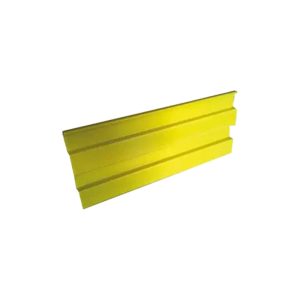 |
Unsere Trittplatte aus GFK ist 100 mm breit und hat eine Wandstärke von 5 mm. Sie ist in 6 m-Längen vorrätig, kann aber bei Bedarf auf die gewünschte Länge zugeschnitten werden. |
Das GFK-Handlaufsystem von TFcomposite besteht aus glasfaserverstärktem Kunststoff (GFK) und wird in China hergestellt. Es bietet im Vergleich zu Stahl entscheidende Vorteile. Deshalb sieht man GFK-Handläufe überall, von Wasseraufbereitungsanlagen bis hin zur Eisenbahnindustrie.
Fiberglass Reinforced Plastic (FRP) handrail systems are advanced, durable solutions for safety and access in industrial, commercial, and architectural applications. They are valued for their strength, corrosion resistance, and low maintenance, making them ideal for environments where traditional materials like steel or wood might fail due to exposure to harsh elements. Below is an in-depth exploration of FRP handrail systems, their components, benefits, applications, installation processes, and maintenance.
1. What is an FRP Handrail System?
An FRP handrail system is a modular or pre-engineered safety barrier system made from fiberglass reinforced plastic, a composite material that combines strong fibers with a polymer matrix. This results in a product that is lightweight, strong, and resistant to corrosion, chemicals, and UV exposure.
Key Components
FRP handrail systems typically consist of:
- Rails: The horizontal components providing continuous support.
- Posts: Vertical elements anchored to the ground or structure to support the rails.
- Knee Rails: Secondary horizontal rails for additional support and safety.
- Toe Boards: Base-level components to prevent tools or debris from falling.
- Armaturen: Connectors, brackets, and fasteners that hold the system together.
- Bases and Mounts: Used to anchor the system to floors, walls, or other surfaces.
2. Materials and Manufacturing
FRP handrail systems are produced using two main manufacturing methods:
- Pultrusion:
- Continuous fibers are pulled through a resin bath and a heated die.
- Ensures uniform strength and a smooth finish.
- Formen:
- Fiberglass mats or woven roving are layered and infused with resin in a mold.
- Often used for complex or custom shapes.
Common Materials in FRP Handrails
- Fibers: Typically glass fibers for high tensile strength.
- Harzarten:
- Polyester: Cost-effective and moderately resistant to chemicals.
- Vinylester: Higher resistance to chemicals and heat.
- Epoxy: Superior mechanical strength and adhesion.
Additives like UV inhibitors, fire retardants, and pigments can be incorporated to enhance performance and aesthetics.
3. Key Benefits of FRP Handrail Systems
FRP handrail systems offer several advantages over traditional materials:
3.1. Corrosion Resistance
- Ideal for environments exposed to chemicals, saltwater, or moisture.
- Used in wastewater plants, marine applications, and chemical processing facilities.
3.2. Lightweight and Easy Installation
- Weighs significantly less than steel or aluminum, reducing transportation and labor costs.
- Modular designs often allow for easy assembly without specialized tools.
3.3. High Strength-to-Weight Ratio
- Provides comparable or superior strength to traditional materials with less bulk.
3.4. Durability and Longevity
- Resists cracking, warping, and degradation over time.
- Long service life even in extreme conditions.
3.5. Low Maintenance
- Requires no painting or frequent inspections.
- Resistant to rust and biological growth.
3.6. Electrical and Thermal Insulation
- Non-conductive, making it safe for electrical environments.
- Low thermal conductivity reduces the risk of burns in high-temperature areas.
3.7. Customizability
- Available in various colors, sizes, and configurations to suit specific requirements.
- Aesthetic options enhance compatibility with architectural designs.
4. Applications of FRP Handrail Systems
FRP handrails are used across diverse industries due to their adaptability and robust properties. Below are examples of key application areas:
4.1. Industrial Facilities
- Chemieanlagen: Withstand chemical splashes and fumes.
- Oil and Gas: Non-corrosive properties ensure longevity in offshore and onshore facilities.
- Kraftwerke: Non-conductive properties provide safety in electrical substations.
4.2. Water and Wastewater Treatment Plants
- Resistant to chlorine, acids, and moisture.
- Ideal for walkways, platforms, and tank access.
4.3. Marine and Coastal Environments
- Unaffected by saltwater corrosion.
- Used on docks, piers, and offshore platforms.
4.4. Public Infrastructure
- Bridges, parks, and pedestrian walkways where safety and aesthetics are essential.
4.5. Commercial and Residential
- Balconies, staircases, and ramps requiring modern, low-maintenance railings.
5. Design Standards and Compliance
FRP handrail systems are often designed to meet rigorous safety and engineering standards, including:
-
OSHA (Occupational Safety and Health Administration):
- Ensures compliance with workplace safety guidelines for handrails.
- Requires specific height, strength, and deflection properties.
-
ASTM (American Society for Testing and Materials):
- Provides testing standards for strength, durability, and material performance.
-
ISO (International Organization for Standardization):
- Covers quality and environmental safety standards globally.
-
ADA (Americans with Disabilities Act):
- Mandates handrail accessibility features, such as smooth surfaces and appropriate height.
6. Installation of FRP Handrail Systems
Installing an FRP handrail system involves the following steps:
6.1. Preparation
- Assess site conditions and ensure the surface is clean and level.
- Mark installation points based on a pre-approved layout or engineering design.
6.2. Assembly
- Install base mounts or brackets at marked points.
- Attach posts to the base mounts using bolts or adhesives.
- Secure horizontal rails and knee rails to the posts using brackets and fasteners.
- Attach toe boards if required.
6.3. Finishing
- Tighten all connections and inspect for alignment.
- Apply sealants or coatings if additional protection is needed.
6.4. Safety Testing
- Perform load tests to ensure compliance with safety standards.
- Inspect for any loose connections or misalignments.
7. Maintenance of FRP Handrail Systems
FRP systems require minimal upkeep, but periodic checks can ensure maximum performance:
7.1. Cleaning
- Use mild soap and water to remove dirt, debris, or grease.
- Avoid abrasive materials to prevent surface scratching.
7.2. Inspection
- Check for loose fittings, bolts, or cracks in the material.
- Inspect joints and connections regularly.
7.3. Repairs
- Damaged components can often be replaced individually without dismantling the entire system.
- Use compatible adhesives or replacement parts from the manufacturer.
8. Customization Options
FRP handrail systems are highly customizable, allowing for adaptation to specific needs:
- Colors: Yellow, green, grey, or custom colors for branding or safety coding.
- Größen: Varying rail diameters and post heights to meet specific requirements.
- Surface Finishes:
- Smooth for aesthetic purposes.
- Textured for slip resistance.
9. Cost Considerations
While the initial cost of FRP handrails may be higher than traditional materials, their long-term cost-effectiveness makes them an attractive option. Key cost factors include:
- Material grade (polyester vs. vinyl ester).
- Customization requirements.
- Installation complexity.
- Quantity and scale of the project.
10. FRP Handrail System vs. Traditional Materials
| Besonderheit | FRP Handrails | Steel Handrails | Aluminum Handrails |
|---|---|---|---|
| Korrosionsbeständigkeit | Exzellent | Arm | Mäßig |
| Gewicht | Leicht | Heavy | Leicht |
| Maintenance | Niedrig | Hoch | Mäßig |
| Stärke | Hoch | Sehr hoch | Mäßig |
| Elektrische Leitfähigkeit | Non-conductive | Conductive | Conductive |
| Cost (Initial) | Moderate to High | Low to Moderate | Hoch |
| Cost (Lifetime) | Niedrig | Hoch | Mäßig |
11. Future Trends
- Enhanced Aesthetics: New pigments and coatings for modern designs.
- Nachhaltigkeit: Use of recycled or eco-friendly resins.
- Smart Systems: Integration of IoT sensors for safety monitoring.
Abschluss
FRP handrail systems are a superior choice for industries and environments requiring durability, safety, and low maintenance. Their adaptability and performance advantages over traditional materials make them a long-term investment for infrastructure and industrial facilities. By leveraging their modular design, ease of installation, and customization capabilities, FRP handrails continue to gain prominence in diverse applications.
Detailed Overview of FRP Handrail Systems
Serie :
Hauptprodukte >Anwendung
Unser GFK-Handlaufsystem wird häufig für die Mehrfach-Querverbindung von GFK-Handläufen und Leitplanken verwendet.
Markenname :
TF-Verbundwerkstoff
Farbe :
gelb oder grau
FAQ
Q :
In welchen Größen und Längen ist das GFK-Handlaufrohr erhältlich?
A :
Das GFK-Rohr wird nur mit einem Außendurchmesser von 50 mm hergestellt und in 5 m-Längen vorrätig gehalten. Bei Bedarf können wir das Rohr auf die gewünschte Länge zuschneiden.
Q :
Wie werden die Armaturen am Rohr befestigt?
A :
Beschläge für GFK-Handläufe werden als zwei identische Hälften geliefert, die einfach um das Rohr herum zusammengeklemmt werden. Diese müssen vor Ort mit einem handelsüblichen HSS-Bohrer mit 9 mm Durchmesser (im Lieferumfang enthalten) gebohrt und mit den mitgelieferten speziellen Nietmuttern aus Edelstahl zusammengeschraubt werden. Die Schrauben werden dann eingesetzt und mit einem Pozidriv-3-Schraubendreher festgezogen. Die Rändelmutternbefestigung bleibt an Ort und Stelle, während die Schraube festgezogen wird. Diese Befestigungen sorgen für einen bündigen Abschluss ohne hervorstehende Schraubenköpfe.
Q :
In welchen Farben sind GFK-Handlaufsysteme lieferbar?
A :
Wir führen die Rohre und Armaturen in Gelb – für hohe Sichtbarkeit – oder Grau.
Andere verwandte Produkte








